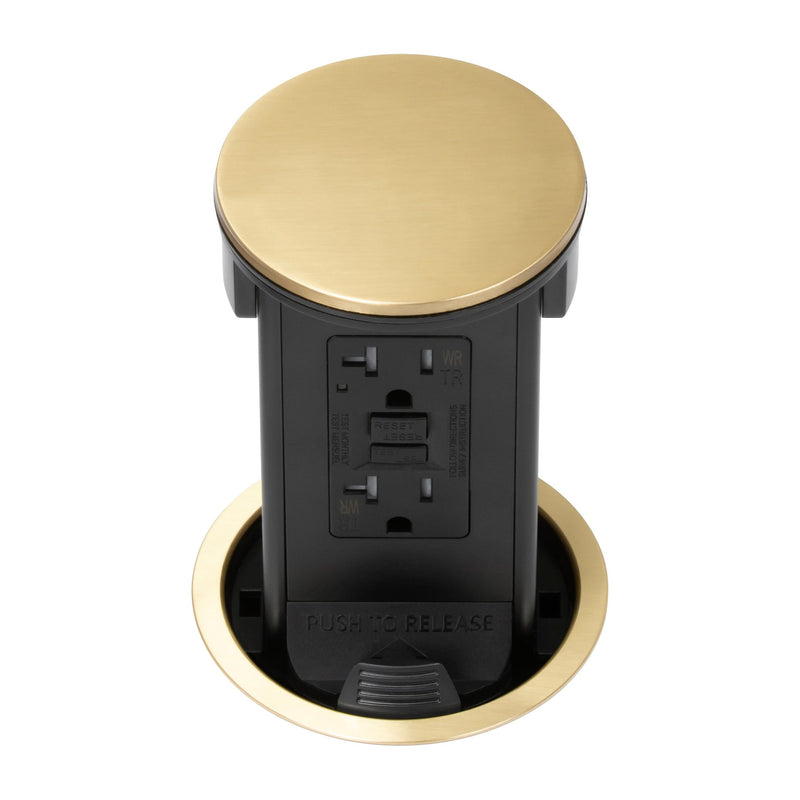- Location
- Illinois
- Occupation
- retired electrician
In some cases the back wall of the island or peninsula is wall space that requires a receptacle.So they can be installed 6” - 9” AFF, in the cabinet wall?
In some cases the back wall of the island or peninsula is wall space that requires a receptacle.So they can be installed 6” - 9” AFF, in the cabinet wall?
According to the listing information at ETL that product is listed as a "furniture power distribution unit" and is not suitable for installation in countertops.We have accepted these before too, on one job. You can see why they are not commonly used...

Lew PUR20GD-B Round Kitchen Pop Up Outlet, GFCI, Brass
Buy the Lew Electric PUR20GD-B pop up receptacle that hides in your kitchen countertop with brass top, 20 Amp outlet, and integrated GFCI protection.www.kitchenpowerpopups.com
I think anything with a cord won't pass as permanent wiring in an island or peninsula. The Hubbell ones have a junction box for a cable or raceway to make the connection.According to the listing information at ETL that product is listed as a "furniture power distribution unit" and is not suitable for installation in countertops.
Yeah, eliminating receptacles leads to extension cord use. Even longer cord to yank on!Slightly different take than @Seven-Delta-FortyOne , IMHO this is a case of code makers identifying a problem but not able to say 'we see a problem but don't have a good solution '.
The problem of cords getting yanked off of islands is real.
Eliminating previously required island receptacles is a poor answer to this real problem.
IMHO a non enforceable 'informational note' in the code, presenting the problem and the lack of solution, would probably lead to workable, practical solutions for the next code cycle.
I'm partial to the idea of trim or moulding that acts to capture the cord. Prevent the dangling loose cord and the risk of snagging the cord goes way down.
If you have a back wall then you probably don't have an island?In some cases the back wall of the island or peninsula is wall space that requires a receptacle.
Next thing could be, we would have to have a retractable cord drop from the overhead, a pendant cord. No cord hanging over the edge then.Yeah, eliminating receptacles leads to extension cord use. Even longer cord to yank on!
Time to start hanging cord reel pendants from the ceiling. I suppose those would be a violation if the cord can reach below the counter level?That loophole is being removed in the 2026 code. No receptacle permitted within 24" of the counter top, measured in any direction other than up.
Were you in my mind? I was writing the same thing when I seen a new post was added, yours.Next thing could be, we would have to have a retractable cord drop from the overhead, a pendant cord. No cord hanging over the edge then.
Mine first, so you must be the mind reader. LOL I can't claim that gift. Just ask my wife.Were you in my mind? I was writing the same thing when I seen a new post was added, yours.
A genuine mind reader wouldn't need to ask. View attachment 2575539
But of course, if you are caught violating one of those rules or regulations, "everyone else is doing it" is not a viable defense.So I, like many in my county, just ignore the vast majority of rules and regulations.
If you have a back wall then you probably don't have an island?
Peninsula would have a back wall to the adjoining counter, but that is not part of the peninsula even though there is only an imaginary line separating the two in most cases.
There are multiple advertisements that are very misleading, approaching the level of fraud, for these products. It is often difficult for the installer or even the inspector to track down what use the product is actually listed for. In this case the information provided included the ETL listing number and from that I could find what use it was actually listed for.Seems like there's a Jeff Foxworthy-esque joke in there somewhere: "If your fully compliant installation on Tuesday becomes a safety-related code violation on Wednesday, and Wednesday's installation was entirely illegal yesterday, then you might need to reconsider your role on a CMP."
This section has been a train wreck for decades, and only gets more dubious as time goes by. I wasn't aware of the "advertising vs listing" of the Lew boxes Don pointed out, that makes it that much more ridiculous. You can't hardly win, aside from breaking the rules after the AHJ leaves the scene and give the customer what they want, which was perfectly legal so recently.
Some of these other brands remind me of unlisted generator interlocks where they try to find some language to imply that they are somehow actually listed. In each case their puffery is borderline fraud.As far as I know the only products listed for countertop use at this time are the Hubbell products.
I saw it under the furniture listing, but also under this one:According to the listing information at ETL that product is listed as a "furniture power distribution unit" and is not suitable for installation in countertops.
| A representative sample of the listed devices have been tested, investigated and found to comply with the requirements of the Standard(s) for Electrical Attachment Plugs and Receptacles (UL-498) and are identified with the ETL Listed Mark. |

